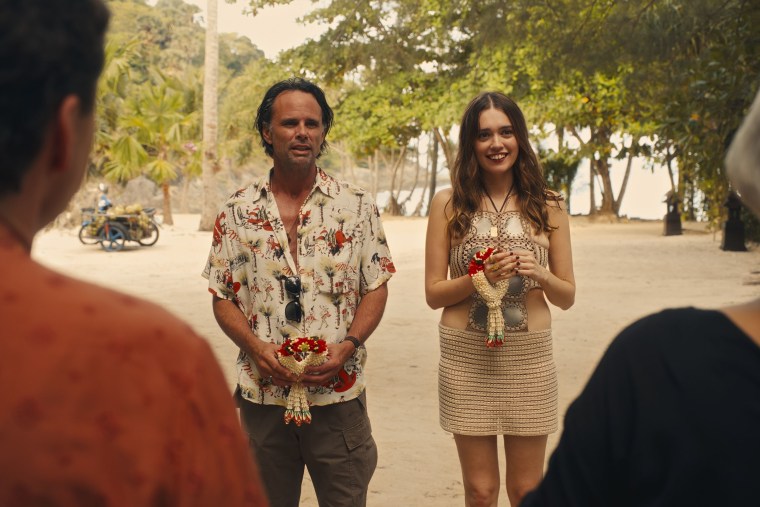Dark, debauched, unhurried and spiritually probing, season three of “The White Lotus” launches Sunday night on Max. A reveal in episode one will have fans squawking like the “chattering monkeys” that the show keeps referencing. Soon after, viewers will be ogling bare-chested (and bare-butted) men so finely hewn they make the hottest guy at your gym look like the bespectacled dork who taught you “World Religions” in college. Which reminds me: Showrunner Mike White is thinking about religion this season. And he is thinking big.
Showrunner Mike White is thinking about religion this season. And he is thinking big.
Season three is set in Thailand at a luxury resort that, we are told, resides one beach over from where the Indian Ocean tsunami claimed thousands of lives in 2004. The country’s reputation for attracting sketchy foreigners, or what a character in the show calls “LBHs” (i.e., Losers Back Home), is fracked for all of its narrative possibilities. So is Thailand’s rich Buddhist heritage. America has periodically experienced Hollywood-induced Zen crazes; maybe season three will trigger another.
The visitors this season, as always, are mostly ultra-wealthy Anglos. Spa guest Piper Ratliff (Sarah Catherine Hook), an undergraduate studying a local Buddhist sage, describes them as “rich bohemians from Malibu in their Lululemon yoga pants.”
Piper’s mom, Victoria (Parker Posey), informs her hosts — though they never asked — that Piper’s brother Lochlan (Sam Nivola) is deciding between Duke and University of North Carolina. The other brother, Saxon, (Patrick Schwarzenegger) is toxic masculinity enfleshed. Saxon attended Duke, as did his finance-guy dad, Timothy (Jason Isaacs), whose forthcoming vacation, I regret to say, will not be restful.
Belinda (Natasha Rothwell) from season one is back. The down-on-her-luck spa manager from Maui, Hawaii, is visiting this White Lotus resort with her son Zion (Nicholas Duvernay) to study with the local masseuses. As was true in season one, her working-woman decency is juxtaposed with the colossal self-absorption of the monied clientele.
Contrast plucky Belinda with Rick Hatchett (Walton Goggins), a criminal who nurses a dark, all-consuming vendetta. Or contrast her with Laurie (Carrie Coon), Jaclyn (Michelle Monaghan) and Kate (Leslie Bibb), three childhood friends who party with the local expat himbos. Each of these 40-something women has an unusual penchant for overhearing the other two disparaging them. Kate from Austin, Texas, overhears her friends making fun of her for being a Trump voter. That may outrage her besties, but the show doesn’t linger on her politics, or anyone else’s. Season three is interested in theology, not ideology.
This “White Lotus,” I repeat, is dark. Gone are the sun-splashed scenes that lit up season two, which White dubbed “a bedroom farce with teeth.” This time around an abundance of scenes are shot at night and twilight. Even at high noon, the frames are saturated with ocher.
Then there’s the darkness of the story itself, which I will leave to viewers to experience on their own terms over the coming weeks.

White, as I pointed out previously, has a genius for making bad decisions look beautiful. In seasons one and two, he let us gawk at humans flaming with desire, entombed within their lusty selves. Season three continues this tradition. We watch exquisitely filmed scenes of people slowly writhing, bingeing, toking, sniffing, gyrating, thrusting and stroking.
But this time he filters his story through a Buddhist prism, a Zen lens. White invites you to spiritually reframe all that revelry. If identity is a prison, if desire is suffering, if the self is an illusion, then what do we make of the impulse that compels you to look good, get swole, influence millions on Instagram, excel in your career, or even create a work of art as ambitious as “The White Lotus”?
White, as I pointed out previously, has a genius for making bad decisions look beautiful.
After visits to Maui, Sicily and Phuket, it’s clear that “The White Lotus” enterprise doesn’t want to be a mere comedy drama anthology television series. The franchise is more like a secular scripture probing questions about inequality, carnality, addiction, manliness (or “brocodes” as they were called in season two) and the legacies of colonialism. It offers few easy answers.
White’s persistent, almost detached curiosity about human vices invokes the work of French filmmaker Éric Rohmer. The legendary director serially interrogated adultery among the French bourgeoisie in works like “Chloe in the Afternoon” (“L’amour L’après-midi”), “Claire’s Knee” (“Le Genou de Claire”) and his “Six Moral Tales” (“Six Contes Moraux”). White’s investigations are far more raunchy and global in their scope. But like Rohmer, he seeks not to solve, but to identify a dilemma.
Season three’s pace is slow in places. Viewers will have to be patient as we wait for White’s characters to eventually, inevitably bottom out. In the meantime, prepare to be unnerved, as I was, by all the poisoned fruit lining the resort’s pathways and a character who warns Belinda: “In time, lizards will become your friends.” When all is said and done, I expect that viewers will, yes, cringe, but also ponder what “enlightenment” actually means. Perhaps White’s turn to Eastern spirituality will help them cope and process what they’ve seen.

